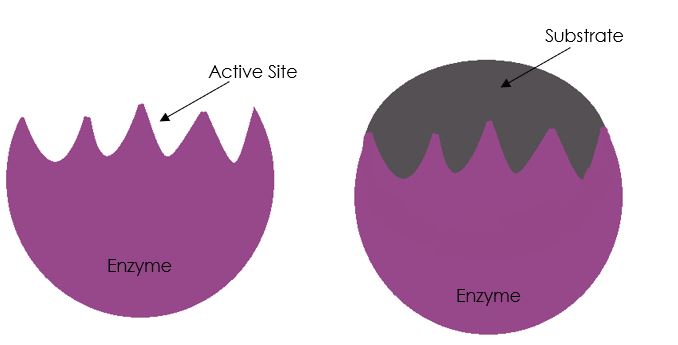What are enzymes?
Enzymes are proteins which are involved in many metabolic reactions in the body. They are commonly referred to as biological catalysts, meaning they speed up the rate of a chemical reaction without undergoing any changes themselves.
Enzymes also have various applications within the food industry and can be used to catalyse different reactions during food processing, such as meat tenderisation.
There are many different types of enzymes including lipases, proteases and cellulases, which all act upon different substrates. A simple way of identifying enzymes is that most use the suffix -ase.
How do enzymes work?
Each enzyme has an active site within its structure. The active site has a specific shape which complements the substrate upon which that enzyme will act. This allows the enzyme and substrate to fit together. This means enzymes are specific as to which reaction they catalyse, depending on which substate their active site aligns with.

How do we measure enzymes?
Enzymes are quantified based on their activity. Unlike some other active ingredients, measuring based upon mass is not appropriate, as that would not outline the potency of the enzyme. Different enzymes use different units to quantify their activity. The Food Chemical Codex (FCC), outlines internationally recognised units of measure for enzymes, alongside the testing methodologies.
See below a range of enzymes we have available alongside their activity. Please note, that we also have a range of diluted enzymes to facilitate with dosing.
|
Enzyme
|
Units
|
Activity
|
|
P01154 Amylase
|
DU- One α-amylase dextrinizing unit is defined as the quantity of α-amylase that will dextrinize soluble starch in the presence of an excess of β-amylase at the rate of 1 g/h at 30°C. The degree of hydrolysis is determined by comparing the iodine colour of the hydrolysate with that of the standard. (FCCVIII)
|
46,566-56,914 DU/g
|
|
P03231 Cellulase
|
One cellulase unit is defined as the amount of activity that will produce a relative fluidity change of 1 in 5 minutes in a defined carboxymethyl cellulose substrate under the conditions of the assay (pH4.5 and 40°C). The degree of hydrolysis of the interior β-1,4-glucosidic bonds corresponds to a reduction in substrate viscosity which is determined using a calibrated viscometer. (FCCVIII)
|
65,034-79,486 CU/g
|
|
P15128 Invertase
|
One Sumner Unit is the quantity of enzyme which will convert 1mg of sucrose to glucose and fructose in 5 minutes under the conditions of the assay (pH 4.5 and 20°C). The amount of monosaccharides produced by hydrolysis of the sucrose substrate is measured spectrophotometrically using a 3,5-Dinitrosalicylic Acid acid-phenol reagent correlated to a glucose standard. (FCCVIII)
|
42,264-51,656 SU/g
|
|
P12010 Lactase
|
One lactase unit is defined as that quantity of enzyme that will liberate o-nitrophenol at a rate of 1μmol/minute under the conditions of the assay (pH 4.5 and 37°C). The hydrolysis of the o-nitrophenylβ-D-galactopyranoside substrate is measured spectrophotometrically. (FCCVIII)
|
4,262-5,210 ALU/g
|
|
P30693 Lactase (High Strength)
|
One lactase unit is defined as that quantity of enzyme that will liberate o-nitrophenol at a rate of 1μmol/minute under the conditions of the assay (pH 4.5 and 37°C). The hydrolysis of the o-nitrophenylβ-D-galactopyranoside substrate is measured spectrophotometrically. (FCCVIII)
|
42,623-52,095 ALU/g
|
|
P12107 Lipase
|
One unit of enzyme activity is defined as that quantity of a standard lipase preparation (Fungi Lipase-International FIP Standard) that liberates the equivalent of 1μmol of fatty acid per minute from the substrate emulsion under the described assay conditions (pH 7.00 and 37°C). The assay is based on the measurement of the amount of free fatty acids formed from an olive oil emulsion in the presence of sodium taurocholate over a fixed time interval. (FCCVIII)
|
194,673-237,934 FIP/g
|
|
P16010 Papain
|
One papain unit is defined as that quantity of enzyme that liberates the equivalent of 1μg of tyrosine per hour under the conditions of the assay (pH 6.0 and 40°C). Unhydrolyzed casein substrate is precipitated with trichloroacetic acid and removed by filtration so the solubilized casein can be measured spectrophotometrically. (FCCVIII)
|
5,047,200- 6,168,800 PU/g
|
|
P16063 Pepsin
|
One pepsin unit is defined as that quantity of enzyme that digests 3,000 times its weight of coagulated egg albumen under the conditions of the assay (52°C).
|
> 3,000,000 Pepsin Units/g
|
|
P16204 Protease
|
One bacterial protease unit is defined as that quantity of enzyme that produces the equivalent of 1.5μg/mL of L-tyrosine per minute under the conditions of the assay (pH 7.0 and 37°C). The assay is a proteolytic hydrolysis of casein in which the unhydrolyzed casein is removed by filtration and the solubilized casein is determined spectrophotometrically. (FCCVIII)
|
115,610-141,302 PC/g
|
|
P02172 Bromelain
|
|
1200 gdu/g
|
|
P02171 Bromelain
|
|
2,500 gdu/g
|
|
P16010 Papain
|
|
5047 FCC units
|
Contact our team for more information